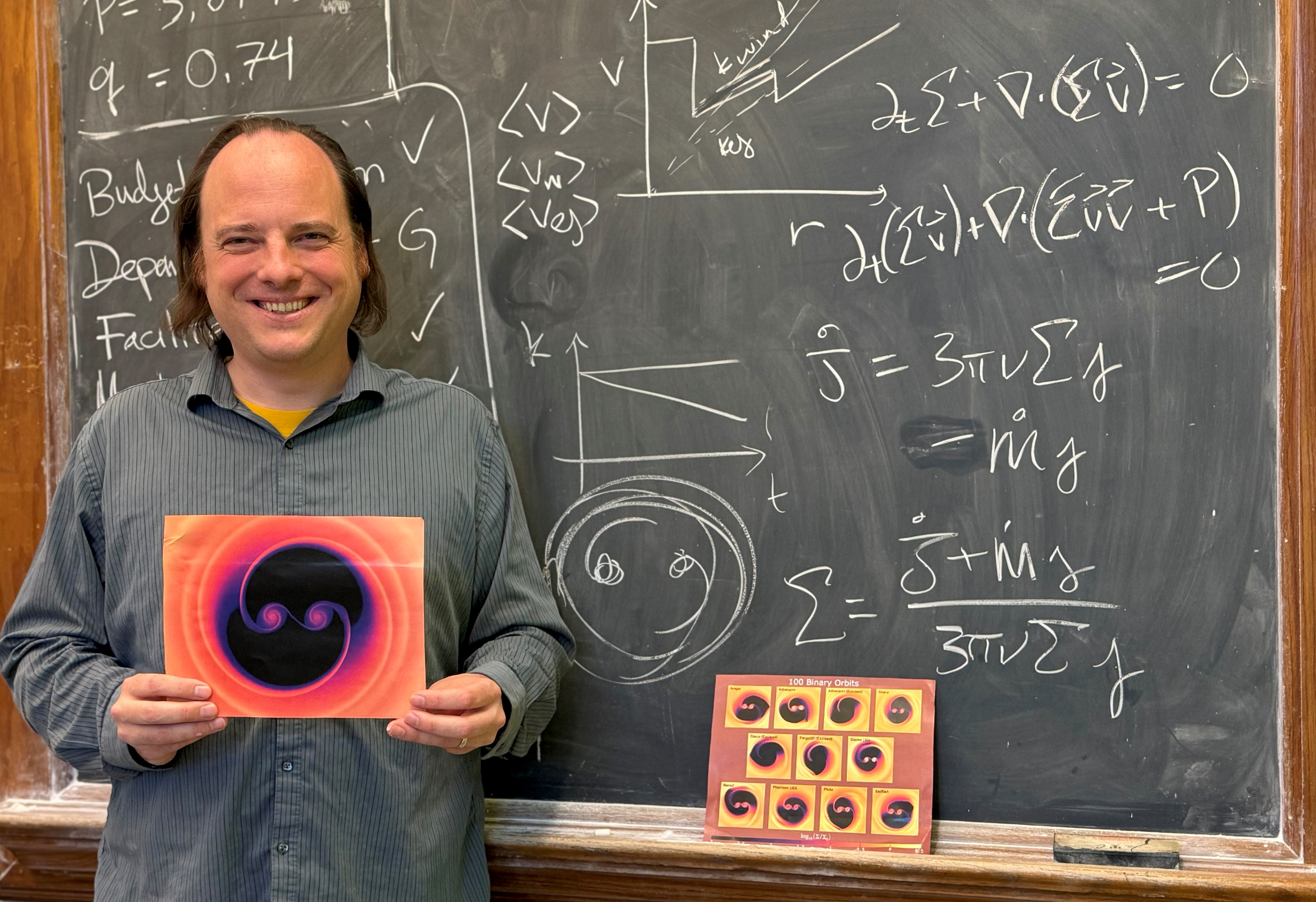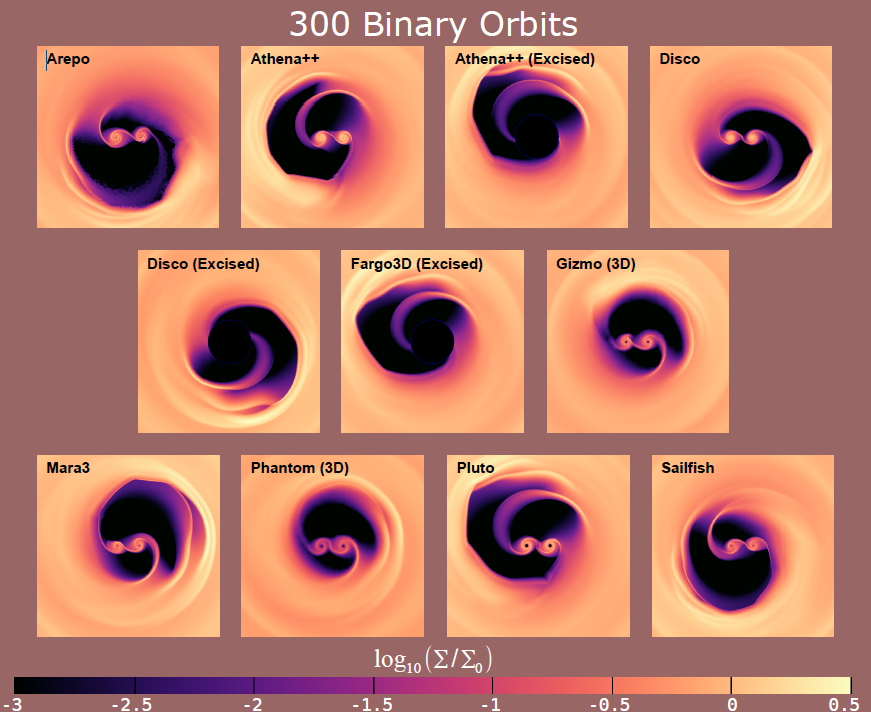Cracking binary mysteries: astrophysicists unify codes
2024-07-29
An international team of astrophysicists tested multiple codes in a quest to establish universal standards

Binary systems occur quite often in our universe. Sprinkled throughout our celestial night sky are examples such as two newly born stars or two merging galaxies with crashing supermassive black holes. Astrophysicists study these binary systems but, through the years, have developed wide-ranging algorithms to help figure out the delicate and difficult math of how they evolve, particularly when interacting with a surrounding disk of gas.
Some problems in astrophysics require very complex mathematical models to describe them, so much so that teams of researchers develop detailed computer algorithms to predict behavior. For very important problems, more than one team will apply their different codes to study the same problem, as the scientific process necessitates comparisons using multiple methods.
One problem in astrophysics has so many scientists interested in the outcome that at least eleven different codes have been used to work out the mathematics of the system's evolution. The problem everyone is so interested in solving is the seemingly simple question of how a binary system interacts with a disk of gas.
An international team of astrophysicists recently met at the Kavli Institute for Theoretical Physics in Santa Barbara, which hosted a several months long program on binary accretion. At this meeting, a daunting question was posed: if these scientists ran different simulation codes that are common to the industry, would all yield the same results? This international team agreed to see this quest through and ran all eleven codes on the same problem and posted their findings in the American Astronomical Society. The publication’s lead author is Paul Duffell, assistant professor at the Purdue University Department of Physics and Astronomy and host of The Astrophysics Podcast.
“These results are important for researchers interested in problems involving accretion disks, especially those relating to binaries,” explains Duffell. “By generating a standard benchmark test problem, it is now possible for anyone trying to do a related problem to test their code and compare with our results first. All eleven codes agreed on these results, so they are pretty robust. All our data has been made public so they can download our results directly and compare with their codes.”
The test was simple. Eleven codes were run on the same problem. Each person has their own code that they have been using on similar problems and the team then compared their findings. Duffell’s code was one that he had written called “Disco.” All data outputs are nonproprietary and available to the public. Links to the codes can be accessed from Duffell’s lab site or from a Zenodo repository.

“One of the main reasons we did this comparison is that many groups had been getting seemingly contradictory answers for very similar setups,” says Duffell. “We wanted to make sure that if all of us ran identical setups, we would get the same answer. It took a lot of work and careful interpretation of our results, but eventually we found we could all agree on our results.”
One of the big questions this study addressed involves whether the binary spirals inward or outward. A question looming over the field is whether the disk exerts a torque on the binary, causing it to spiral inward as it interacts with the disk.
“One major result of the past few years is that many groups found the opposite, that the disk gave torque to the binary, causing it to spiral outward,” says Duffell. “Some groups seemed to get one answer and others seemed to get another. But of course, we always had slightly different setups, so it was often explained away ‘your group isn't including X or Y in their code.’ One big reason for doing a code comparison is to make sure all our codes got the same answer to the same problem. And we do! It turns out, at least for our setup, the torque is positive, meaning the binary spirals outward due to interaction with the disk. This result was considered very counter-intuitive when first suggested, but people are now coming around to it.”
This study was extensive and boasted an international collaboration of partner institutions. Institutions who contributed code results are: University of Maryland, Los Alamos National Laboratory, Niels Bohr Institute (Denmark), University of Zurich (Switzerland), University of Milan (Italy), INFN (National Institute for Nuclear Physics in Milan), University of Arizona, University of Tubingen (Germany), Imperial College of London, Universite Claude Bernard Lyon 1 (France), Harvard Center for Astrophysics, Fudan University (China), University of Cambridge (UK), Caltech and Clemson University. Additionally, a number of coauthors who contributed to the publication without submitting code results are from Columbia University, Università degli Studi dell’Insubria (Italy), Florida Atlantic University, West Virginia University and Perimeter Institute for Theoretical Physics.
The study had multiple coauthors who each contributed their own code’s calculations to the results of the publication. They are:
- Alexander Dittmann at the University of Maryland
- Daniel D’Orazio at the Niels Bohr Institute in Copenhagen, Denmark
- Alessia Franchini at the University of Zürich, Switzerland
- Kaitlin Kratter at the University of Arizona
- Anna Penzlin at the University of Tübingen, Germany
- Enrico Ragusa at the University of Milan, Italy
- Magdalena Siwek at the Harvard Center for Astrophysics
- Christopher Tiede at the Niels Bohr Institute in Copenhagen, Denmark
- Haiyang Wang at Fudan University in Shanghai, China
- Jonathan Zrake at Clemson University in Clemson, South Carolina
“There are other fields that can benefit from understanding of this fundamental astrophysics problem, but suffice to say, many different groups in many different fields in astrophysics perform calculations of a gaseous disk accreting onto a binary system,” says Duffell. “It's basically the same exact problem, whether you're studying stars or black holes.”
This research was funded in part by NSF grant AAG-2206299.
About the Department of Physics and Astronomy at Purdue University
Purdue’s Department of Physics and Astronomy has a rich and long history dating back to 1904. Our faculty and students are exploring nature at all length scales, from the subatomic to the macroscopic and everything in between. With an excellent and diverse community of faculty, postdocs and students who are pushing new scientific frontiers, we offer a dynamic learning environment, an inclusive research community and an engaging network of scholars.
Physics and Astronomy is one of the seven departments within the Purdue University College of Science. World-class research is performed in astrophysics, atomic and molecular optics, accelerator mass spectrometry, biophysics, condensed matter physics, quantum information science, and particle and nuclear physics. Our state-of-the-art facilities are in the Physics Building, but our researchers also engage in interdisciplinary work at Discovery Park District at Purdue, particularly the Birck Nanotechnology Center and the Bindley Bioscience Center. We also participate in global research including at the Large Hadron Collider at CERN, many national laboratories (such as Argonne National Laboratory, Brookhaven National Laboratory, Fermilab, Oak Ridge National Laboratory, the Stanford Linear Accelerator, etc.), the James Webb Space Telescope, and several observatories around the world.
About Purdue University
Purdue University is a public research institution demonstrating excellence at scale. Ranked among top 10 public universities and with two colleges in the top four in the United States, Purdue discovers and disseminates knowledge with a quality and at a scale second to none. More than 105,000 students study at Purdue across modalities and locations, including nearly 50,000 in person on the West Lafayette campus. Committed to affordability and accessibility, Purdue’s main campus has frozen tuition 13 years in a row. See how Purdue never stops in the persistent pursuit of the next giant leap — including its first comprehensive urban campus in Indianapolis, the Mitchell E. Daniels, Jr. School of Business, Purdue Computes and the One Health initiative — at https://www.purdue.edu/president/strategic-initiatives.
Contributors:
Paul Duffell, assistant professor at the Purdue University Department of Physics and Astronomy
Written by Cheryl Pierce, Communications Specialist